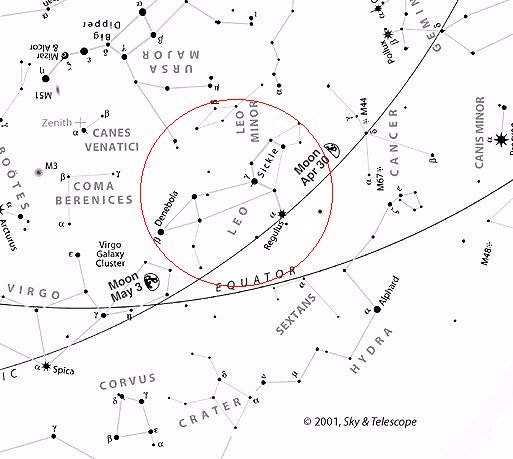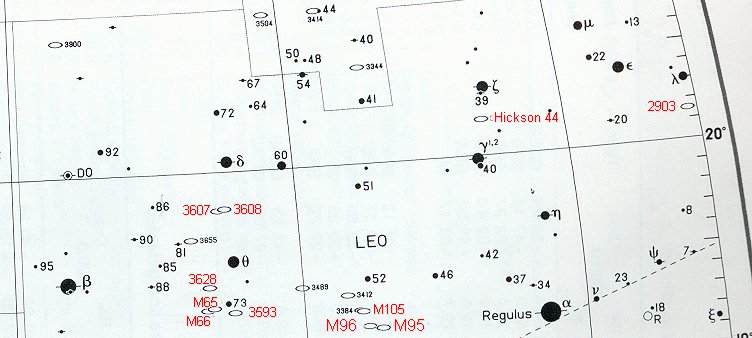May 2001
Leo the Lion
 Leo is a great
constellation. It's bright and easy to find, even from the light polluted
suburbs. Plus, its one of the few constellations that actually looks
like what its supposed to represent! To find Leo in May, go outside
at about 9:30 (or as soon as its really dark), and look high the south
southwest. The brightest star in Leo is Regulus, which marks the
bottom of the "Sickle". The Sickle is an asterism (a grouping of
stars), that also looks like a backwards question mark. The Sickle marks
the head and front paws of Leo.
Leo is a great
constellation. It's bright and easy to find, even from the light polluted
suburbs. Plus, its one of the few constellations that actually looks
like what its supposed to represent! To find Leo in May, go outside
at about 9:30 (or as soon as its really dark), and look high the south
southwest. The brightest star in Leo is Regulus, which marks the
bottom of the "Sickle". The Sickle is an asterism (a grouping of
stars), that also looks like a backwards question mark. The Sickle marks
the head and front paws of Leo.
If you have trouble spotting Leo, use the Big Dipper as a guide. Just
as the "Pointer Stars"point north to the North Star, Polaris, they
also point in the opposite direction toward the Sickle. The hindquarters
of Leo are marked by a right triangle of birght stars, the brightest of
which is Denebola, which means "tail of the Lion."
It is interesting to note that thousands of years ago, around 2240 B.C.,
Leo was home to the Summer Solstice. The Summer Solstice marks the
sun's northernmost point in the sky, and signals the beginning of Summer
in the Northern Hemisphere. Although we think of the Solstices and the
Equinoxes as fixed points, they move with time due to the Precession
of the Earth's axis. The Earth is like a top that wobbles, and therefore
points in different directions over time. The pole star, which is now Polaris,
was once Thuban, in the constellation Draco. One day in the
future, Vega (in Lyra), will be our pole star. But getting
back to the Summer Solstice, since ancient times it has drifted eastward,
and now lies between Taurus and Gemini. That is why these
two constellations are best viewed in winter, because the sun is farthest
from them at that time.

In this more detailed view, (adapted from Norton's Sky Atlas 2000.0)
we'll take a closer look at some of the
interesting sights in Leo, almost all of which are galaxies. In April
and May, we are facing away from the bright core of our own galaxy; thus
the Spring Sky is filled with our galactic neighbors. We're going
to go in order of right ascension, which is right to left on this map.
The vertical lines are the right ascension lines. All these objects are
best viewed with a telescope, unless otherwise noted. The descriptions
are based on views with 8 and 10 " Dobsonian telescopes from dark skies.
They can also be found on the Interactive
NGC Catalog Online, or by following the links I have provided. The
numbers in parentheses are measurements of the object's brightness in magnitude.
NGC 2903. (8.9) One of the larger galaxies in Leo, it has a bright
core, surrounded by a flat, elliptical disk.
Hickson 44. (NGC 3190 (11.0), 3193 (10.9), 3187 (13.1), and 3185
(12.2)) This compact group of five galaxies includes 4 that can be glimpsed
in moderate size scopes. For more info and a great picture of this
quintet, click here.
g Leo. This double star is part of
the Sickle, and is the bright star under Hickson 44. Its a very close
double, because the separation between its components is only 4.4 arcseconds.
Both stars are very bright also, at magnitudes 2.2 and 3.5
M95 and M96. (9.7, 9.2) This famous Messier pair is located
east of Regulus. Both galaxies are barred spirals and look great in almost
any telescope. More
info.
M105, NGC 3384 and NGC 3389. (9.3, 10.0, 11.8) The "Leo Trio"
is one of the best galaxy groupings in the entire sky. It lies just north
of M95 and 96, and M105 is the brightest of the three. More
info about the Leo Trio.
NGC 3607 and 3608. (10.0, 11.0) This is actually another trio,
well placed between d and q
, with NGC 3605 as the third galaxy. But 3605 is magnitude 13, pushing
the limits of moderate sized scopes. 3607 and 3608 are both small with
bright cores.
M65, M66,
NGC 3628, and
NGC 3593. (9.3,
9.0, 9.5, 11.0) This grouping could be called the "Leo Quartet", although
they are not as close as the Hickson 44 group. M65 and 66 are very
easy to spot, each having bright cores. 3593 appears larger but fainter.
For a small map of these galaxies, click here.
88 Leo. We end our tour of Leo with another double star, located
between b and q. The
components are magnitude 6.4 and 8.4, and are separated by 8.4 arcseconds.
The colors are yellowish and bluish, respectively.
Back to Night Sky Observers main page.
 Leo is a great
constellation. It's bright and easy to find, even from the light polluted
suburbs. Plus, its one of the few constellations that actually looks
like what its supposed to represent! To find Leo in May, go outside
at about 9:30 (or as soon as its really dark), and look high the south
southwest. The brightest star in Leo is Regulus, which marks the
bottom of the "Sickle". The Sickle is an asterism (a grouping of
stars), that also looks like a backwards question mark. The Sickle marks
the head and front paws of Leo.
Leo is a great
constellation. It's bright and easy to find, even from the light polluted
suburbs. Plus, its one of the few constellations that actually looks
like what its supposed to represent! To find Leo in May, go outside
at about 9:30 (or as soon as its really dark), and look high the south
southwest. The brightest star in Leo is Regulus, which marks the
bottom of the "Sickle". The Sickle is an asterism (a grouping of
stars), that also looks like a backwards question mark. The Sickle marks
the head and front paws of Leo.
